Alternate history: M96 Cup engine
Discussion
This is going to be long, and rambling, and potentially very boring - it's a story that currently has no end, and indeed may never have a happy one.
It's the story of an engine, specifically an engine that never was, and potentially might be at some point in the (hopefully near) future.
Most people have a good understanding of the history of the 996 - it was launched with a development of the water cooled flat six from the Boxster, pushed to 3.4 litres, but the decision was taken to install a water cooled evolution of the older air-cooled motor to create a high performance version that would be called the GT3. The same engine also appeared in the turbo, and the Porsche Cup cars (with changes appropriate to each, of course).
Slightly less well known is the X51 Powerkit, a comprehensive upgrade package for the M96 engine that was created when Porsche was evaluating whether the M96 had what it took to be the base engine and the high performance version.
For the 996.1 this kit was extremely comprehensive, encompassing an additional oil scavenge pump, heavily revised sump, X51 specific heads, pistons, cams, valves, a whole new cast aluminium intake (instead of the stock plastic unit) and much larger diameter exhaust manifolds, an additional central radiator and a revision to the DME to manage all the changes. This wasn't a red badge and a tweak to the map - the engine was gone through from top to bottom and almost every system was revised or enhanced.
And, of course - it wasn't enough. The decision was made that the Mezger was the way forward and the rest was history.
The X51 kit continued to be offered, but with each subsequent iteration it was less comprehensive, and whilst certainly more than a trim level it was never as comprehensive as it was in its original form.
Over the years the M96 has become the butt of many jokes, the chocolate engine, the engine Porsche wanted to forget, and with the move to the 9A1 architecture it largely was.
I have to admit though, I liked it - characterful, makes a great noise with a sports exhaust, plenty of shove low down but some real zing in the upper reaches of the rev range. I had bought my 996 on 60,000 miles, and decided that I was going to run the engine through a prophylactic Hartech rebuild before it hit 100,000 in order to preserve all the things I liked, but remove the weaknesses that were well known to bedevil the M96 (and some that were less well known, but still needed to be engineered out).
Around this time PopPopBangBang had the engine in his very well known 996 C4 rebuilt, in his case by Autofarm, and pushed to 3.7 litres.
He was good enough to publish some estimated power power and torque plots for his revised engine, and it was clear that the new unit had more horsepower and torque- both delivered lower down in the rev-range.
This was clearly a strong indication that when I got my engine rebuilt I should swap from the 96mm bore to the 100mm bore in order to take my 3.4 to (the obviously much more desirable) 3.7.
But, why stop there? It occurred to me that if one were to add the X51 kit to the 3.7 then it's higher lift cams, flowed heads and increased rev limit might create a unit that continued making power when standard 3.7's were already changing gear, an engine that potentially answered the question "what if Porsche *didn't* choose the Mezger?"
I started to put together a wish-list for my new engine, a list that could be summarised in two key points: remove the weaknesses of the M96 and add drama in the form of revs and power.
First, the weaknesses.
It's the story of an engine, specifically an engine that never was, and potentially might be at some point in the (hopefully near) future.
Most people have a good understanding of the history of the 996 - it was launched with a development of the water cooled flat six from the Boxster, pushed to 3.4 litres, but the decision was taken to install a water cooled evolution of the older air-cooled motor to create a high performance version that would be called the GT3. The same engine also appeared in the turbo, and the Porsche Cup cars (with changes appropriate to each, of course).
Slightly less well known is the X51 Powerkit, a comprehensive upgrade package for the M96 engine that was created when Porsche was evaluating whether the M96 had what it took to be the base engine and the high performance version.
For the 996.1 this kit was extremely comprehensive, encompassing an additional oil scavenge pump, heavily revised sump, X51 specific heads, pistons, cams, valves, a whole new cast aluminium intake (instead of the stock plastic unit) and much larger diameter exhaust manifolds, an additional central radiator and a revision to the DME to manage all the changes. This wasn't a red badge and a tweak to the map - the engine was gone through from top to bottom and almost every system was revised or enhanced.
And, of course - it wasn't enough. The decision was made that the Mezger was the way forward and the rest was history.
The X51 kit continued to be offered, but with each subsequent iteration it was less comprehensive, and whilst certainly more than a trim level it was never as comprehensive as it was in its original form.
Over the years the M96 has become the butt of many jokes, the chocolate engine, the engine Porsche wanted to forget, and with the move to the 9A1 architecture it largely was.
I have to admit though, I liked it - characterful, makes a great noise with a sports exhaust, plenty of shove low down but some real zing in the upper reaches of the rev range. I had bought my 996 on 60,000 miles, and decided that I was going to run the engine through a prophylactic Hartech rebuild before it hit 100,000 in order to preserve all the things I liked, but remove the weaknesses that were well known to bedevil the M96 (and some that were less well known, but still needed to be engineered out).
Around this time PopPopBangBang had the engine in his very well known 996 C4 rebuilt, in his case by Autofarm, and pushed to 3.7 litres.
He was good enough to publish some estimated power power and torque plots for his revised engine, and it was clear that the new unit had more horsepower and torque- both delivered lower down in the rev-range.
This was clearly a strong indication that when I got my engine rebuilt I should swap from the 96mm bore to the 100mm bore in order to take my 3.4 to (the obviously much more desirable) 3.7.
But, why stop there? It occurred to me that if one were to add the X51 kit to the 3.7 then it's higher lift cams, flowed heads and increased rev limit might create a unit that continued making power when standard 3.7's were already changing gear, an engine that potentially answered the question "what if Porsche *didn't* choose the Mezger?"
I started to put together a wish-list for my new engine, a list that could be summarised in two key points: remove the weaknesses of the M96 and add drama in the form of revs and power.
First, the weaknesses.
I'd never thought of using anyone other than Hartech to rebuild the engine - their knowledge of the M96 is unparalleled, and Baz Hart is an extremely talented engineer and (rather helpfully) a very nice chap. I spent ages on the phone with both Baz and Grant, and their willingness to share their knowledge really made this project possible. Hartech race the M96 engines and have developed fixes which address the weaknesses exposed by both road and track use - incredibly useful empirical knowledge of the engine, won the hard way.
Now, the M96 has an intermediate shaft that runs beneath the crank and transfers power to the cams via chains, and the oil pump via a 50mm hexagonal key. It's got an oil fed plain bearing at the oil pump end, and at the other a sealed bearing - the infamous IMS bearing. This is the beté noire of the M96 according to Porsche folklore, and it's said to be simply a matter of time before it destroys every engine in which it is found.
This isn't quite true, and anyway for the new engine we'd use the final development of the IMSB from the M97 - a much larger bearing than used in the 996 versions, so large in fact that it can't be installed or removed without splitting the engine cases.
Next on the list was crank flex- the construction of the M96 is such that the crank has a marked cantilever from the final main bearing to the flywheel, and this, when combined with vigorous use of the clutch and revs can flex the crankshaft, leading to rapid wear of the main bearings, leaking Rear Main Seals (RMS) and - in extremis - snapped crankshafts. Hartech offer an EN40B crankshaft (which a good friend who joined me in the project chose for his engine, more on this in due course) and also they can machine the engine case and install an additional bearing just behind the flywheel which constrains the degree to which the crank can flex, and essentially removes this problem.
Now, I was determined to spin the engine past 8,000 rpm - I wanted fuel cut at ~8,500. This meant we had to look at the valve train, and by this point a chap from 911UK who has an incredible knowledge of racing engines had offered his assistance. We quickly identified the tappet chest as a weak link, for numerous reasons.
For one, it was cheap crap - a weak casting with the bare minimum of material required, and was known to suffer from hydraulic fracturing in normal road use. As new camshaft blanks were not available for the M96 we'd also need to re-grind stock ones, hence would have a smaller base-circle, which would mean that the tappets would ride higher in their bores, and would need both more support and the oiling hole position changing.
It was clear that we needed a new tappet chest, as we simply couldn't modify the existing one to meet our requirements. By this point I'd managed to infect another chap from 911UK with my obsession, and he'd decided to build not one but two engines to our new "X51 Cup" specification, and very rapidly it became apparent that without his input we'd have got nowhere fast.
We ran a stock tappet chest through a scanner, creating a highly detailed (and enormous) digital image of it. My partner then created a CAD model from the digital image, and in consultation with the engine designer we created a new tappet chest that addressed the weaknesses of the OEM one. I emailed Richard Brunning (of Bad Obsession Motorsport fame) and asked if he had a recommendation for a machine shop that could do the work - step forward Specialist Engineering, who created this prototype for us:



Finally, the oiling system - an integrated dry-sump in Porsche speak, disparagingly called a wet-sump by almost everyone else, but actually somewhere in-between.
In it's stock form the integrated dry-sump tank is formed from a plastic baffle that sits in the centre of the sump, and whilst the engine is in operation the oil is returned to this internal tank. Sadly, the tank isn't exactly oil-tight, and under heavy G the oil can escape into the rest of the sump. This is largely resolved by fitting the X51 sump which has an aluminium baffle/tank with rubber seals that fit tightly against the internal walls of the sump and do a much better job of keeping the internal tank full under G. This just left the issue with the heads - or, rather, the right hand head (as you look at the car from behind). To save money Porsche used the same casting for both heads, so the drive end of the cams is at the back on the right, and at the front on the left. Each head has an oil scavenge pump that returns oil to the central tank/sump, and under normal conditions this works fine.
However, under heavy braking, and especially if the car is turning left, oil pools in the front of the right hand head as the scavenge pump is at the back, and for that brief period is sucking air. Porsche resolved this by fitting a dual stage scavenge pump to this head that scavenges the front of the head via a port on the cam cover, to which it is connected via external hard-line (the iconic X51 towel-rail). So - buy the dual stage pump and problem solved, right? Sadly not - the currently available dual stage pump spins backwards, which we considered to be sub-optimal. So we made our own:
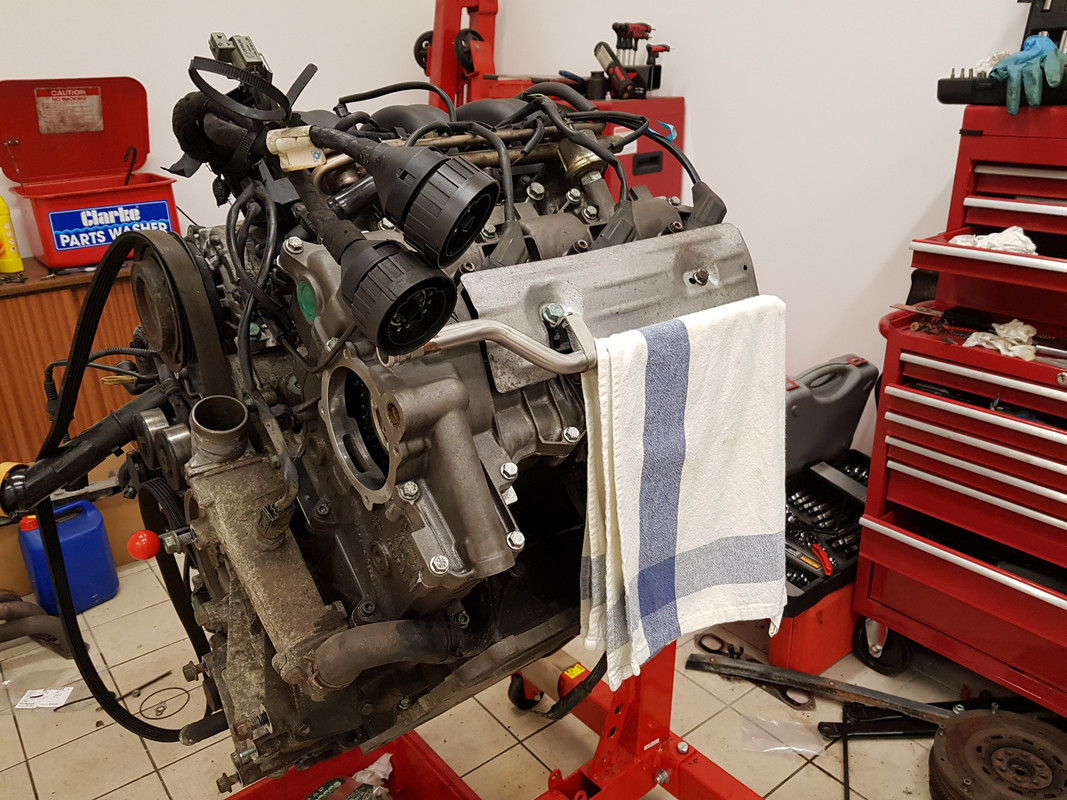
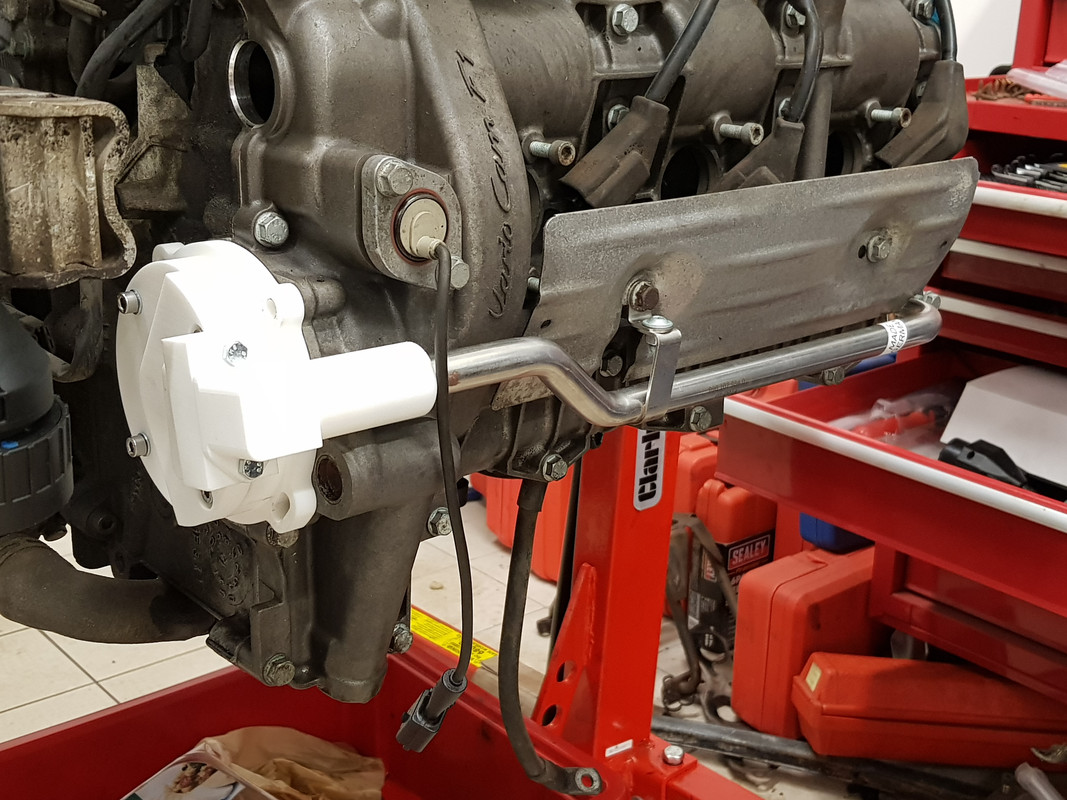
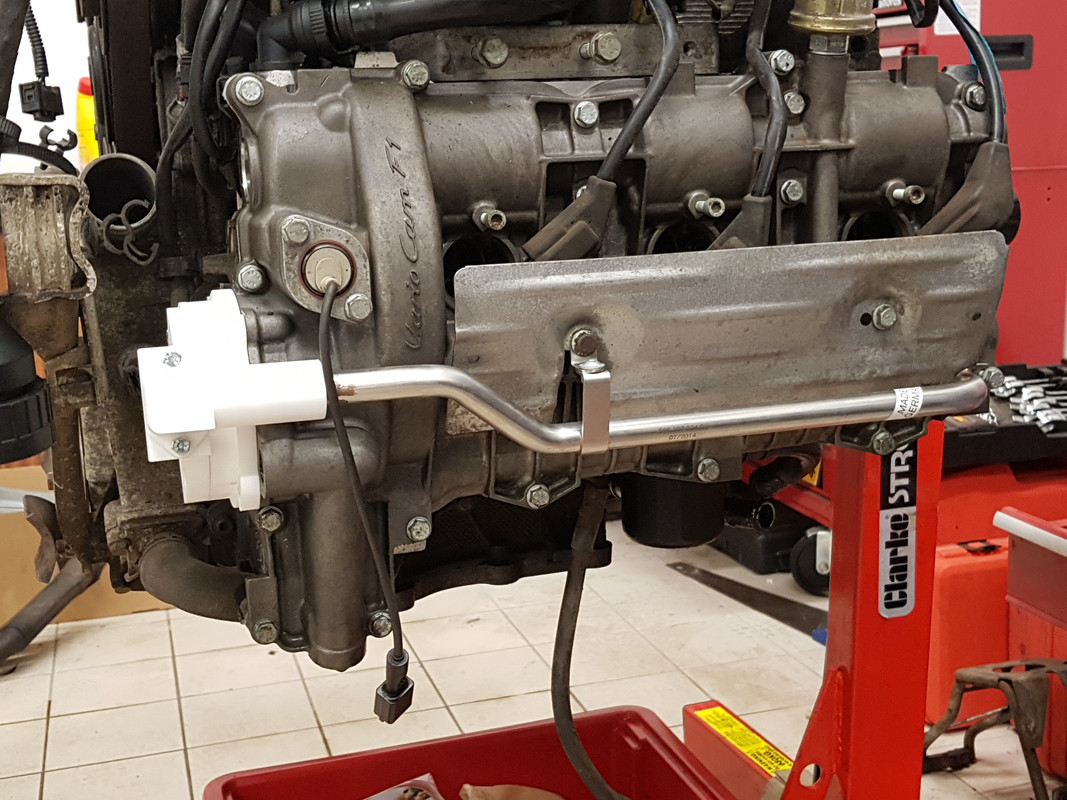
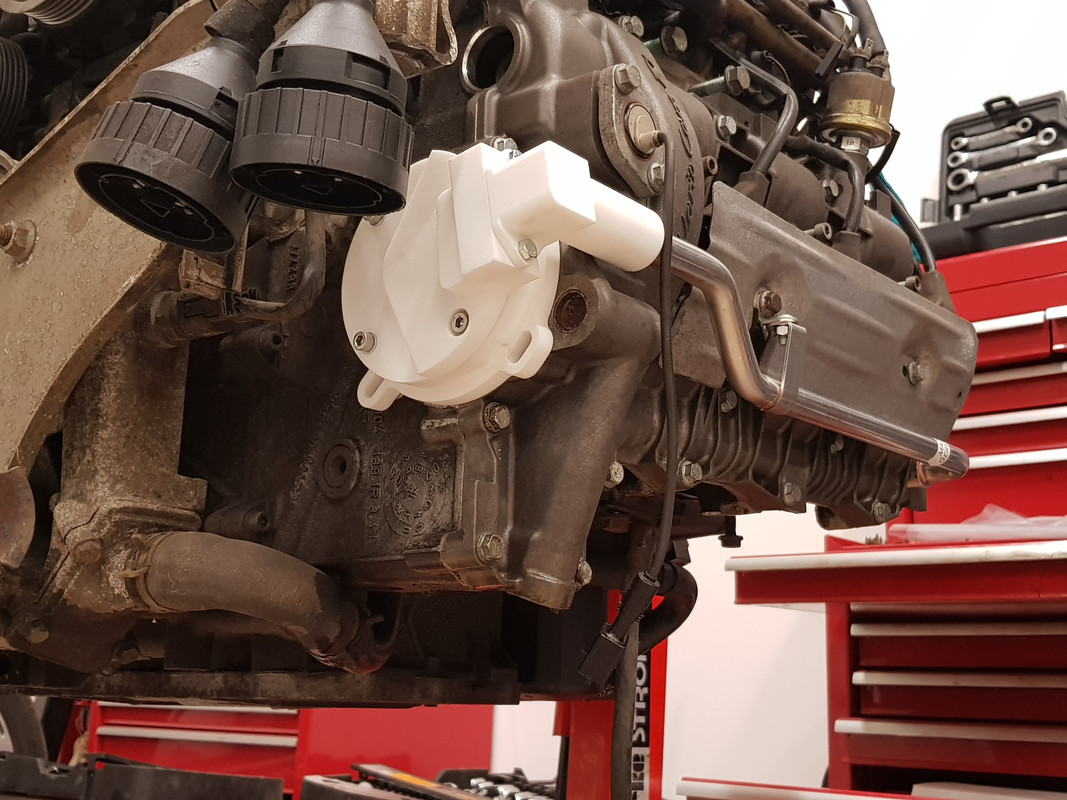
Leading too:
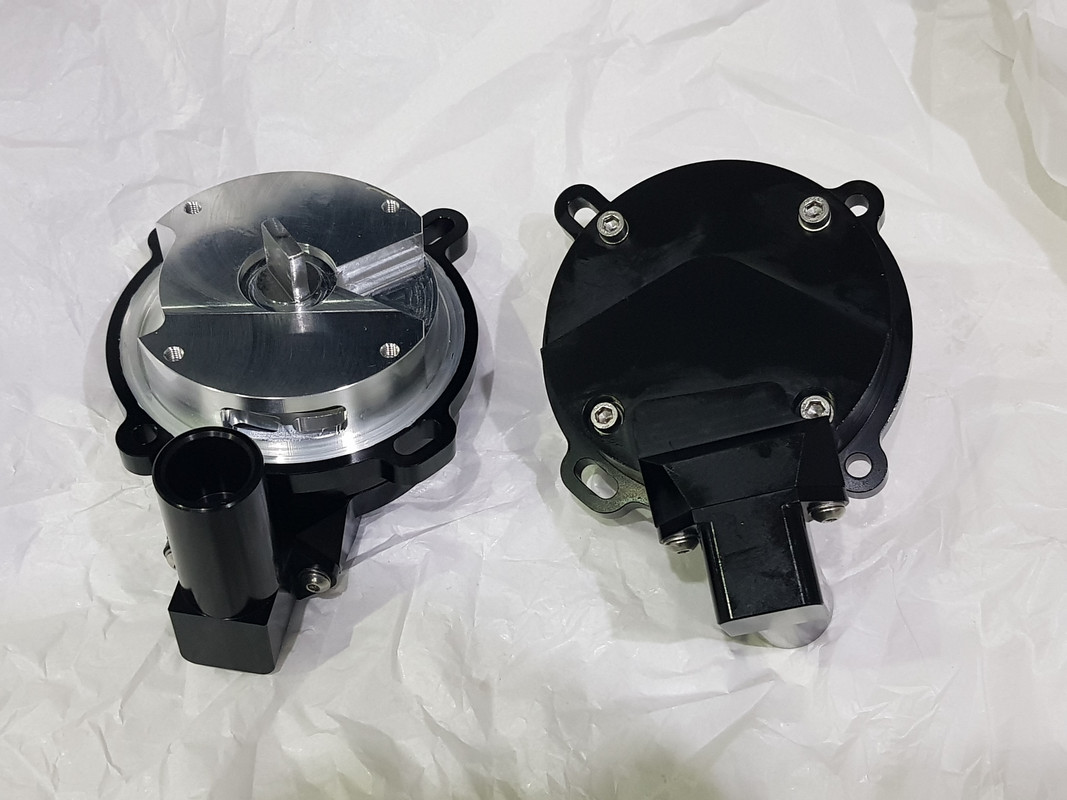
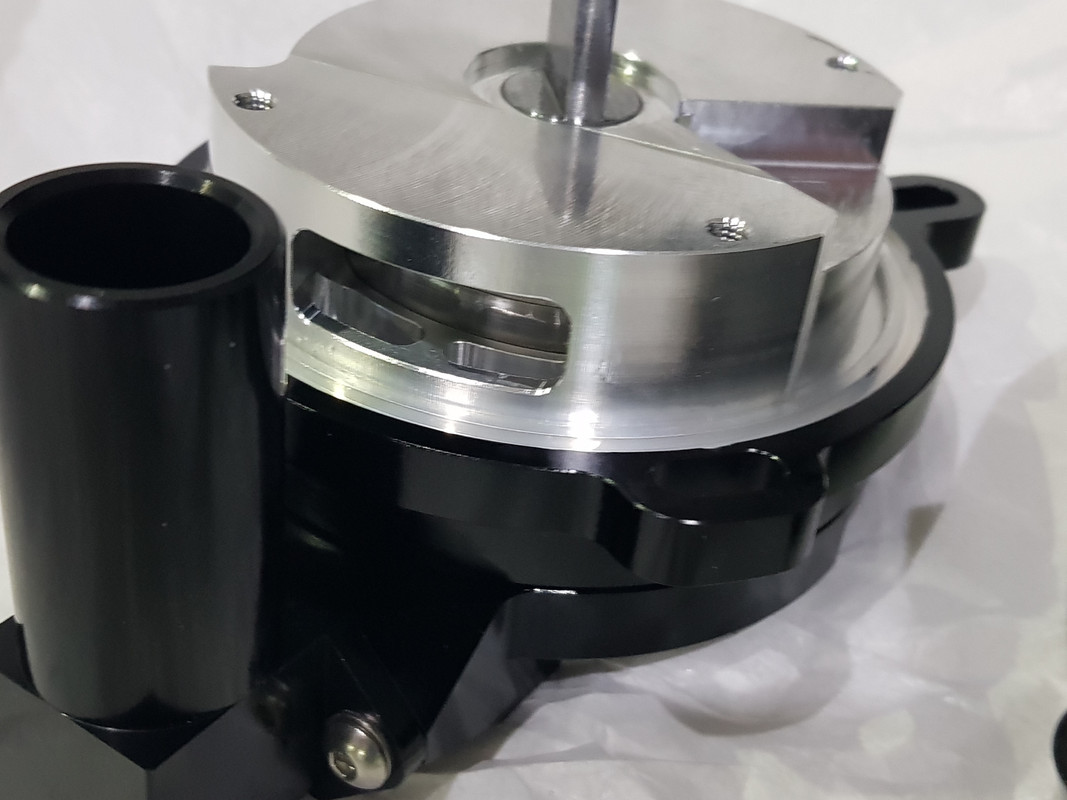
Now, the M96 has an intermediate shaft that runs beneath the crank and transfers power to the cams via chains, and the oil pump via a 50mm hexagonal key. It's got an oil fed plain bearing at the oil pump end, and at the other a sealed bearing - the infamous IMS bearing. This is the beté noire of the M96 according to Porsche folklore, and it's said to be simply a matter of time before it destroys every engine in which it is found.
This isn't quite true, and anyway for the new engine we'd use the final development of the IMSB from the M97 - a much larger bearing than used in the 996 versions, so large in fact that it can't be installed or removed without splitting the engine cases.
Next on the list was crank flex- the construction of the M96 is such that the crank has a marked cantilever from the final main bearing to the flywheel, and this, when combined with vigorous use of the clutch and revs can flex the crankshaft, leading to rapid wear of the main bearings, leaking Rear Main Seals (RMS) and - in extremis - snapped crankshafts. Hartech offer an EN40B crankshaft (which a good friend who joined me in the project chose for his engine, more on this in due course) and also they can machine the engine case and install an additional bearing just behind the flywheel which constrains the degree to which the crank can flex, and essentially removes this problem.
Now, I was determined to spin the engine past 8,000 rpm - I wanted fuel cut at ~8,500. This meant we had to look at the valve train, and by this point a chap from 911UK who has an incredible knowledge of racing engines had offered his assistance. We quickly identified the tappet chest as a weak link, for numerous reasons.
For one, it was cheap crap - a weak casting with the bare minimum of material required, and was known to suffer from hydraulic fracturing in normal road use. As new camshaft blanks were not available for the M96 we'd also need to re-grind stock ones, hence would have a smaller base-circle, which would mean that the tappets would ride higher in their bores, and would need both more support and the oiling hole position changing.
It was clear that we needed a new tappet chest, as we simply couldn't modify the existing one to meet our requirements. By this point I'd managed to infect another chap from 911UK with my obsession, and he'd decided to build not one but two engines to our new "X51 Cup" specification, and very rapidly it became apparent that without his input we'd have got nowhere fast.
We ran a stock tappet chest through a scanner, creating a highly detailed (and enormous) digital image of it. My partner then created a CAD model from the digital image, and in consultation with the engine designer we created a new tappet chest that addressed the weaknesses of the OEM one. I emailed Richard Brunning (of Bad Obsession Motorsport fame) and asked if he had a recommendation for a machine shop that could do the work - step forward Specialist Engineering, who created this prototype for us:



Finally, the oiling system - an integrated dry-sump in Porsche speak, disparagingly called a wet-sump by almost everyone else, but actually somewhere in-between.
In it's stock form the integrated dry-sump tank is formed from a plastic baffle that sits in the centre of the sump, and whilst the engine is in operation the oil is returned to this internal tank. Sadly, the tank isn't exactly oil-tight, and under heavy G the oil can escape into the rest of the sump. This is largely resolved by fitting the X51 sump which has an aluminium baffle/tank with rubber seals that fit tightly against the internal walls of the sump and do a much better job of keeping the internal tank full under G. This just left the issue with the heads - or, rather, the right hand head (as you look at the car from behind). To save money Porsche used the same casting for both heads, so the drive end of the cams is at the back on the right, and at the front on the left. Each head has an oil scavenge pump that returns oil to the central tank/sump, and under normal conditions this works fine.
However, under heavy braking, and especially if the car is turning left, oil pools in the front of the right hand head as the scavenge pump is at the back, and for that brief period is sucking air. Porsche resolved this by fitting a dual stage scavenge pump to this head that scavenges the front of the head via a port on the cam cover, to which it is connected via external hard-line (the iconic X51 towel-rail). So - buy the dual stage pump and problem solved, right? Sadly not - the currently available dual stage pump spins backwards, which we considered to be sub-optimal. So we made our own:




Leading too:


Edited by Dammit on Sunday 26th April 22:14
With the weaknesses taken care of we had to think about how we were going to get enough air through the engine. I had purchased an X51 intake, but it soon became apparent that an intake optimised for a 7,200 rpm wasn't going to cut-it at 8,200 rpm. I sold the X51 intake having never taken it out of it's box - losing a mere £500 for the privilege of having it on a shelf for six months.
With the decision taken there was only really one choice - individual throttle bodies had to be the way forward.
We had a look at what was available - a choice of one, essentially, with Jenvey making a kit. We decided to go our own way, and started adapting some BMW M3 ITB's:

Initially our thinking was to use the variable length centre section from the later 4.0 RS as a plenum to feed the ITB's:

But we may go with ordinary ram-pipes initially, more on this as we continue to develop the intake side of things.
With the decision taken there was only really one choice - individual throttle bodies had to be the way forward.
We had a look at what was available - a choice of one, essentially, with Jenvey making a kit. We decided to go our own way, and started adapting some BMW M3 ITB's:

Initially our thinking was to use the variable length centre section from the later 4.0 RS as a plenum to feed the ITB's:

But we may go with ordinary ram-pipes initially, more on this as we continue to develop the intake side of things.
The heads have been extensively ported, and the results on the flow bench were very promising, however Mike was convinced that the geometry of the valve seats was holding us back. New, larger valves (paired with titanium retainers and new, stronger double valve springs) allowed him to re-profile the seats for another significant increase in flow.






Fantastic read and epic project. Full marks for getting into the very upper echelons of project escalation! Some beutiful work in the pictures.
But Porsche did choose the Mezger, probably with good reason. It is regarded by all as the pinacle of the water cooled engines, the definative motorsport engine for the road, with character, chatter, performance and reliability.
I sincerely hope your end result gives you a lot of pleasure and that the journey does too. But unless Hartech are doing a good portion of the development at ‘mates rates’ as a research project it looks like a bit of a financial black hole.
But Porsche did choose the Mezger, probably with good reason. It is regarded by all as the pinacle of the water cooled engines, the definative motorsport engine for the road, with character, chatter, performance and reliability.
I sincerely hope your end result gives you a lot of pleasure and that the journey does too. But unless Hartech are doing a good portion of the development at ‘mates rates’ as a research project it looks like a bit of a financial black hole.
Yes, I never claimed that this made sense - but it's fun.
Bore and stroke - the standard 3.4 engine has a 96mm bore, and the Lokasil liners are an open-deck design which ovalise over time.
They can be fitted with reinforcement rings, but a better solution is to machine them out and replace with Nikasil liners, and whilst you're there close the deck.
And, if you are machining out the liners and replacing them - why not go for a little extra displacement?
Initially I was going to use my existing 3.4 litre engine, but as development went on I was made an offer on a brand new 3.2 litre (Boxster S) block that was impossible to refuse. The 3.2 is identical to the 3.4 in every dimension that mattered for me, and the new 100mm liners combined with the 3.4 crank yielded 3.7 litres. Martin decided to build a 3.7 for his existing early 996 coupe, and a 3.9 (using a 996.2 3.6 litre bottom end) for his new project car, a 996.1 C4 converted to RWD.
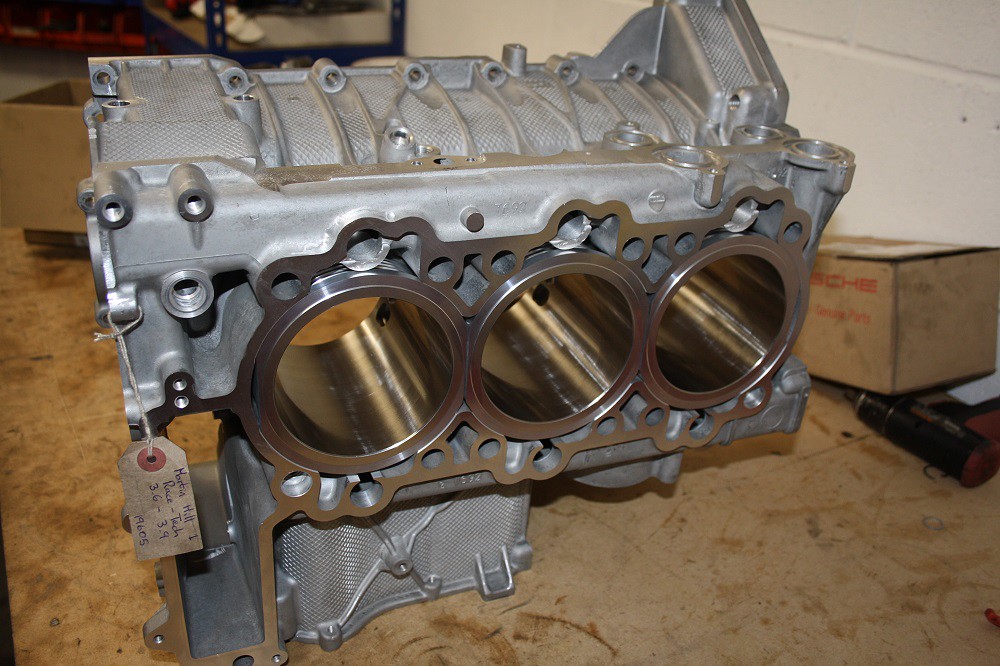

New 100mm pistons matched to the new bores:

And three fresh engine blocks waiting to be built up:

We need to finalise our con-rod dimensions and get them ordered, then we can assemble an engine and run it up on the dyno.
We're so very close now - but there's still so much to do.
Bore and stroke - the standard 3.4 engine has a 96mm bore, and the Lokasil liners are an open-deck design which ovalise over time.
They can be fitted with reinforcement rings, but a better solution is to machine them out and replace with Nikasil liners, and whilst you're there close the deck.
And, if you are machining out the liners and replacing them - why not go for a little extra displacement?
Initially I was going to use my existing 3.4 litre engine, but as development went on I was made an offer on a brand new 3.2 litre (Boxster S) block that was impossible to refuse. The 3.2 is identical to the 3.4 in every dimension that mattered for me, and the new 100mm liners combined with the 3.4 crank yielded 3.7 litres. Martin decided to build a 3.7 for his existing early 996 coupe, and a 3.9 (using a 996.2 3.6 litre bottom end) for his new project car, a 996.1 C4 converted to RWD.


New 100mm pistons matched to the new bores:

And three fresh engine blocks waiting to be built up:

We need to finalise our con-rod dimensions and get them ordered, then we can assemble an engine and run it up on the dyno.
We're so very close now - but there's still so much to do.
Outstanding effort.
I've only skimmed so far, shall return for a proper read but wanted to thank you for taking the time to put this thread together plus of course the massive effort gone into the engine - could help many others decisions.
I believe it was Jethro Bovingdon that commented along the lines of "if it wasn't for the Mezger, the M96 would be considered a great Porsche engine'.
I've only skimmed so far, shall return for a proper read but wanted to thank you for taking the time to put this thread together plus of course the massive effort gone into the engine - could help many others decisions.
I believe it was Jethro Bovingdon that commented along the lines of "if it wasn't for the Mezger, the M96 would be considered a great Porsche engine'.
I'd not heard that - but I immediately agree with his observation.
To go with the ITB's we're going to use a lightweight flywheel - I could give you many performance reasons for those choices, but frankly I'd do it just for the sound they promise.
For me the sensations of Motorsport always started with the noise - the rising intonation followed by a brief pause, then a further escalating shriek of the cars running on the straight followed by what to me was always the most intoxicating sound - the driver prepares the car for a corner, engine barking in repeated short bursts whilst they change down through the gears. That whap-whap-whap almost like a super-bike engine revving on the starting grid. It was the first thing that struck you as you walked into a racing circuit, then the smell of hot motor-oil competing with that of the doughnut stands, and finally the sight of the cars themselves, primary colours of sponsors logos, flaring brake discs and flaming exhausts. But ever present, the noise- spine tingling howls punctuated by staccato barks, the defining aural signature of the sport.
My car may be a little silver bath-tub with a canvas roof, but one day soon it's going to make the noise.
To go with the ITB's we're going to use a lightweight flywheel - I could give you many performance reasons for those choices, but frankly I'd do it just for the sound they promise.
For me the sensations of Motorsport always started with the noise - the rising intonation followed by a brief pause, then a further escalating shriek of the cars running on the straight followed by what to me was always the most intoxicating sound - the driver prepares the car for a corner, engine barking in repeated short bursts whilst they change down through the gears. That whap-whap-whap almost like a super-bike engine revving on the starting grid. It was the first thing that struck you as you walked into a racing circuit, then the smell of hot motor-oil competing with that of the doughnut stands, and finally the sight of the cars themselves, primary colours of sponsors logos, flaring brake discs and flaming exhausts. But ever present, the noise- spine tingling howls punctuated by staccato barks, the defining aural signature of the sport.
My car may be a little silver bath-tub with a canvas roof, but one day soon it's going to make the noise.
Fascinating thread thank you! I have a 997 C4S X51 so watching with great interest. I have fallen completely in love with mine and have a Hartech rebuild in mind in the future as it’s definitely a keeper.
The midrange howl is addictive and it pulls like a train. Yours is going to be another level by the looks of it!
Good luck.
The midrange howl is addictive and it pulls like a train. Yours is going to be another level by the looks of it!
Good luck.
Gearing - the standard box has pretty long ratios, adding ~1,000 rpm to each gear would make them intergalactic.
Also, the engine is going to come on cam from around 4,000 rpm, then scream past 8,000 before fuel cut forces you to grab another gear.
Long gears are not going to work here - they'd take forever to get into the power band, and when you change they'll drop you out of it again, a recipe for frustration.
The stock box is, frankly, somewhat of a pain here- it requires a fairly hirsute press to get the gears off the shafts, and of course back on again.
Albins (in Skippie-ville) make gearsets which can be swapped in, should you have an Esau edition press in your workshop, and said gears are helical so should be fairly mild mannered.
There is also the option of straight cut gears from the likes of Guard, but I'm uncertain that I could cope with the noise (beyond what would undoubtedly be the hysterical first drive).
We did look at using the GT3/turbo box, but the different dimensions make this very difficult (and conversations with companies such as Quaife revealed that they'd tried and failed to convert their Cup box to work with M96 variants), so modifying the stock box appears to be the way forward.
Current plan is to dyno the engine, then extrapolate the required ratios from the shape of the curve that we get, in order to drop into the power band each time another gear is selected, then order a stack of suitable gears from Australia.
Somewhat undecided as to whether it would be a good idea to make the whole box very short, or leave sixth as a much longer gear for cruising on the motorway.
Also, the engine is going to come on cam from around 4,000 rpm, then scream past 8,000 before fuel cut forces you to grab another gear.
Long gears are not going to work here - they'd take forever to get into the power band, and when you change they'll drop you out of it again, a recipe for frustration.
The stock box is, frankly, somewhat of a pain here- it requires a fairly hirsute press to get the gears off the shafts, and of course back on again.
Albins (in Skippie-ville) make gearsets which can be swapped in, should you have an Esau edition press in your workshop, and said gears are helical so should be fairly mild mannered.
There is also the option of straight cut gears from the likes of Guard, but I'm uncertain that I could cope with the noise (beyond what would undoubtedly be the hysterical first drive).
We did look at using the GT3/turbo box, but the different dimensions make this very difficult (and conversations with companies such as Quaife revealed that they'd tried and failed to convert their Cup box to work with M96 variants), so modifying the stock box appears to be the way forward.
Current plan is to dyno the engine, then extrapolate the required ratios from the shape of the curve that we get, in order to drop into the power band each time another gear is selected, then order a stack of suitable gears from Australia.
Somewhat undecided as to whether it would be a good idea to make the whole box very short, or leave sixth as a much longer gear for cruising on the motorway.
Glad that some of you chaps find what we're doing interesting - hopefully at some point this year we'll have a dyno chart to show whether it worked or not.
Cams.
The 3.4 litre M96 engine has four camshafts, two per bank, with the exhaust cam being driven from the intermediate shaft (yes, that intermediate shaft) via a chain.
The inlet cam is driven from the exhaust cam, again via a chain - the tension on the chain can be varied, which changes the inlet cam timing. This is called VarioCam, a simple system that has an annoying appetite for the (expensive) actuating solenoid.
Unlike more sophisticated systems there is no variation in valve lift with this system - that came with VarioCam+ on the 3.6 litre engine of the 996.2.
In the X51 package for the 3.4 Porsche changed both inlet and exhaust camshafts, interestingly the earliest engines came with lash caps whilst the later ones featured longer valve stems (valve diameters remained the same).
With the 3.6 X51 package Porsche elected to only change the exhaust cam, the inlet now having variable lift courtesy of the "+".
We had a good look for the lift and duration of the X51 cams, but the paucity of information (Porsche themselves were totally unwilling to provide any data) combined with the cost prompted us to look elsewhere.
No one makes cam shaft blanks for these, and billet cams are a) expensive and b) accelerate wear in the valve train.
That left us with Schrick cams, or re-grinds. First we looked at the Schrick offering and, whilst it was interesting, we weren't a fan of some design elements and also decided that having a grind that was 100% orientated around our requirements was the optimal solution.
This does mean reducing the base circle, but we have our billet tappet chest (so we can adjust where the upper edge of the bore of the tappet is relative to the centreline of the cam, and the oiling) and our own valves (as we upped the diameter for both inlet and exhaust) so this has been accounted for.
At the moment the thinking is to have three options - fast road/track/race, but I suspect we'd be unable to resist the temptation of fitting the lumpiest cams with the highest duration. We'll see - the cam designer can grind to order, so we don't need to make our minds up until quite a late stage.
The cams in the 3.4 are shared with the 3.2 Boxster S, so when in a 3.7 (my car) or a 3.9 (Martins) they're a significant limiting factor, therefore this was an important thing to get right.
I think three of the things that we paid the most attention to were valve and valve spring material, weight and form, every aspect of which then informed the cam design. I'm reliably informed that valve train float is A Bad Thing, so attention here is important.
Anyway, suffice it to say that whichever of the three profiles we end up putting in the engines the valves will open further, for longer.
Interestingly this has knock on effects in other areas - the Porsche exhaust cams are (relatively speaking) rather inoffensive little things, so choice of exhaust manifold design doesn't really make a huge difference. Moving to rather spikier cams means that we now need to optimise the exhaust for the cam design, so equal length primaries become important, although we're constrained by the packaging when it comes to primary length (there being a finite amount of room between the underside of the engine and the road), still we should be able to get a decent amount of tube under there.
Cams.
The 3.4 litre M96 engine has four camshafts, two per bank, with the exhaust cam being driven from the intermediate shaft (yes, that intermediate shaft) via a chain.
The inlet cam is driven from the exhaust cam, again via a chain - the tension on the chain can be varied, which changes the inlet cam timing. This is called VarioCam, a simple system that has an annoying appetite for the (expensive) actuating solenoid.
Unlike more sophisticated systems there is no variation in valve lift with this system - that came with VarioCam+ on the 3.6 litre engine of the 996.2.
In the X51 package for the 3.4 Porsche changed both inlet and exhaust camshafts, interestingly the earliest engines came with lash caps whilst the later ones featured longer valve stems (valve diameters remained the same).
With the 3.6 X51 package Porsche elected to only change the exhaust cam, the inlet now having variable lift courtesy of the "+".
We had a good look for the lift and duration of the X51 cams, but the paucity of information (Porsche themselves were totally unwilling to provide any data) combined with the cost prompted us to look elsewhere.
No one makes cam shaft blanks for these, and billet cams are a) expensive and b) accelerate wear in the valve train.
That left us with Schrick cams, or re-grinds. First we looked at the Schrick offering and, whilst it was interesting, we weren't a fan of some design elements and also decided that having a grind that was 100% orientated around our requirements was the optimal solution.
This does mean reducing the base circle, but we have our billet tappet chest (so we can adjust where the upper edge of the bore of the tappet is relative to the centreline of the cam, and the oiling) and our own valves (as we upped the diameter for both inlet and exhaust) so this has been accounted for.
At the moment the thinking is to have three options - fast road/track/race, but I suspect we'd be unable to resist the temptation of fitting the lumpiest cams with the highest duration. We'll see - the cam designer can grind to order, so we don't need to make our minds up until quite a late stage.
The cams in the 3.4 are shared with the 3.2 Boxster S, so when in a 3.7 (my car) or a 3.9 (Martins) they're a significant limiting factor, therefore this was an important thing to get right.
I think three of the things that we paid the most attention to were valve and valve spring material, weight and form, every aspect of which then informed the cam design. I'm reliably informed that valve train float is A Bad Thing, so attention here is important.
Anyway, suffice it to say that whichever of the three profiles we end up putting in the engines the valves will open further, for longer.
Interestingly this has knock on effects in other areas - the Porsche exhaust cams are (relatively speaking) rather inoffensive little things, so choice of exhaust manifold design doesn't really make a huge difference. Moving to rather spikier cams means that we now need to optimise the exhaust for the cam design, so equal length primaries become important, although we're constrained by the packaging when it comes to primary length (there being a finite amount of room between the underside of the engine and the road), still we should be able to get a decent amount of tube under there.
Dammit said:
Interestingly this has knock on effects in other areas - the Porsche exhaust cams are (relatively speaking) rather inoffensive little things, so choice of exhaust manifold design doesn't really make a huge difference. Moving to rather spikier cams means that we now need to optimise the exhaust for the cam design, so equal length primaries become important, although we're constrained by the packaging when it comes to primary length (there being a finite amount of room between the underside of the engine and the road), still we should be able to get a decent amount of tube under there.
Good to know there are other lunatics hell bent on cramming as much N/A horsepower in the most unorthodox manner possible, under the engine cover of a narrowbody 996 Neil 
If these fit under my steed :
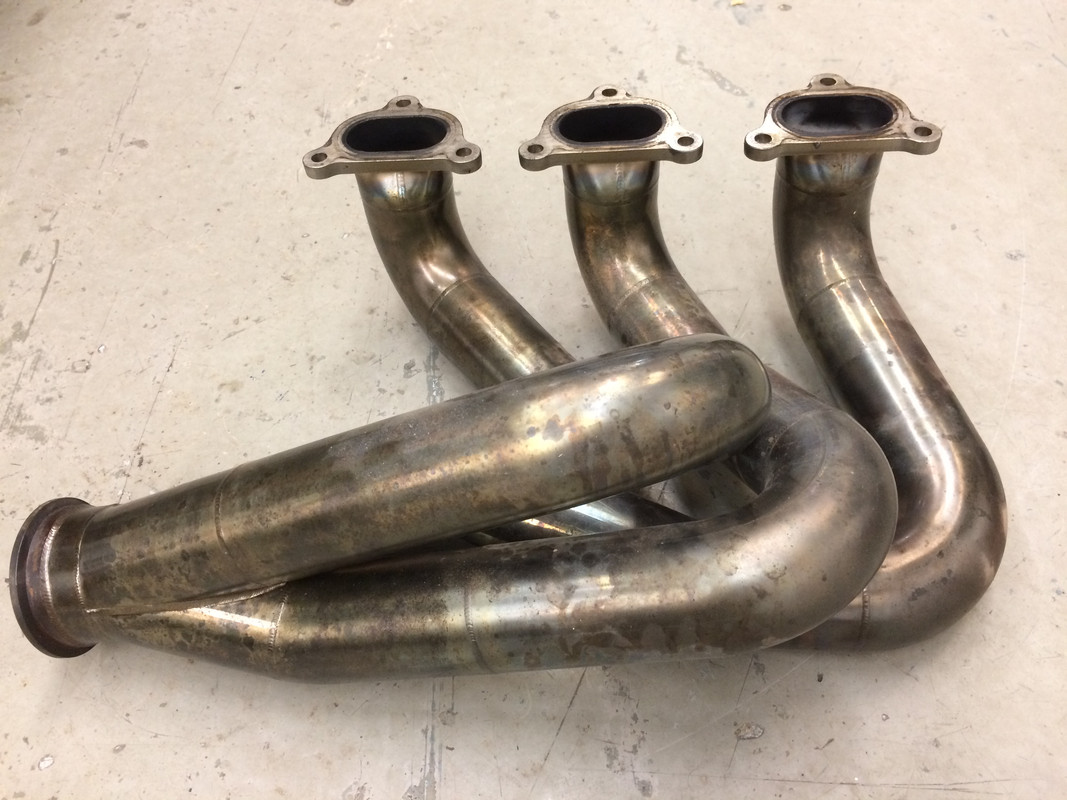

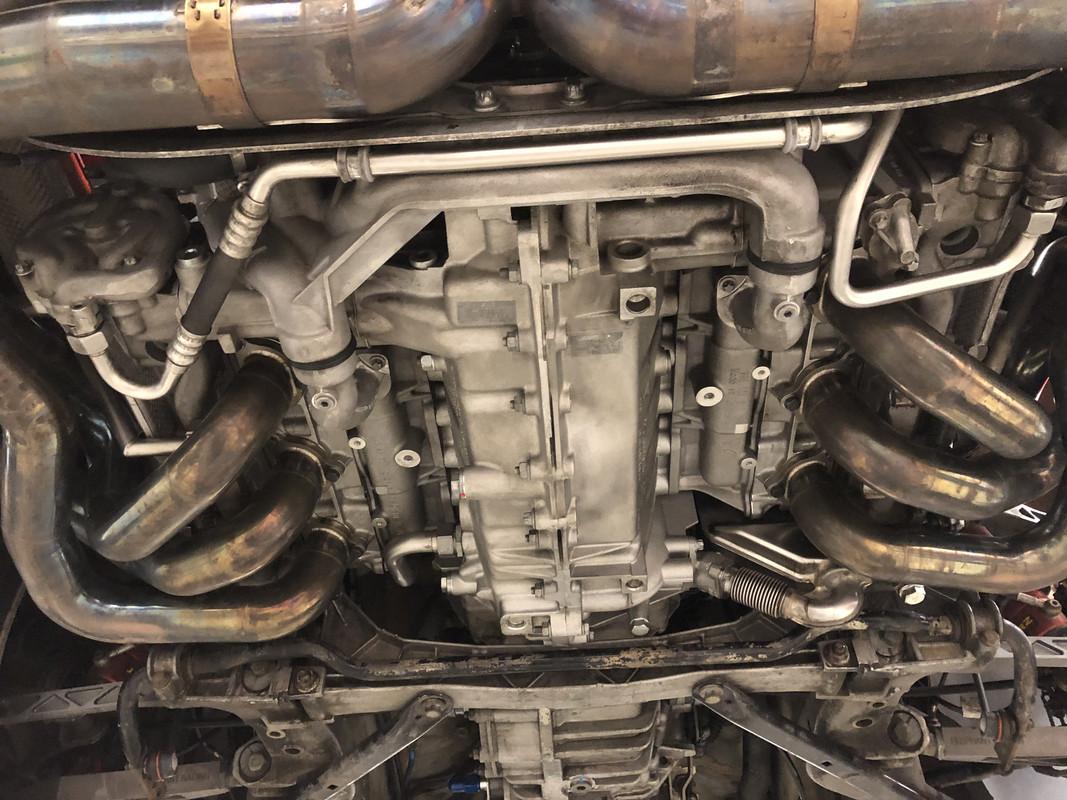
I'm sure you'll be able to get something as, or more impressive, under yours and Martins ...
Replied to read in detail later.
What great project! Bravo and thanks for the detailed post. Surely a valuable source of resource!
Only one question arised already: what didn't you like about the Schricks design? Something specific about your build, or something in general.
Just asking out of curiosity, since they are a highly regarded manufacturer of camshafts, at least in Germany.
What great project! Bravo and thanks for the detailed post. Surely a valuable source of resource!
Only one question arised already: what didn't you like about the Schricks design? Something specific about your build, or something in general.
Just asking out of curiosity, since they are a highly regarded manufacturer of camshafts, at least in Germany.
Gassing Station | 911/Carrera GT | Top of Page | What's New | My Stuff




